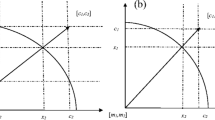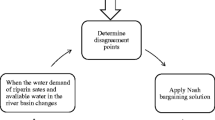Abstract
Transboundary water conflicts research is important to the development and progress of economic society. Water resources allocation is an effective means of solving the water conflicts. In this research, a one-to-many Rubinstein bargaining water resources allocation conceptual model (OMRBCM) is proposed to solve transboundary water conflict. In the proposed model, the quotation strategy is constructed considering the minimum survival water demand, and the discount factor is determined quantitatively based on the principles of fairness and efficiency. The OMRBCM is transformed into a one-to-one Rubinstein bargaining water resources allocation model (OORBM) by introducing the virtual opponent concept. The OMRBCM considering the principles of fairness and efficiency is compared with that only considering the fairness or efficiency principle. The rationality of the quotation strategy considering the minimum survival water demand is analyzed. The Taian section of the Dawen River Basin is selected as a case study. The results reveal that (1) the virtual opponent simplifies the calculation process of the water resources allocation scheme and reduces the number of one-to-one negotiations. (2) The discount factor based on the principles of fairness and efficiency can better balance the economic and social development levels among stakeholders; (3) The quotation strategy considering the minimum survival water demand can guarantee that the basic water demands of stakeholders are met, making the result more reasonable. The proposed model and analysis results offer decision-making support for transboundary issues that do not have political boundaries and provide a new method for obtaining reasonable water resources allocation schemes.







Similar content being viewed by others
Data Availability
Data is available upon reasonable request to the corresponding author.
References
Abolpour B, Javan M, Karamouz M (2007) Water allocation improvement in river basin using adaptive neural fuzzy reinforcement learning approach. Appl Soft Comput 7(1):265–285. https://doi.org/10.1016/j.asoc.2005.02.007
Bajany DM, Zhang L, Xu Y, Xia X (2021) Optimisation approach toward water management and energy security in arid/semiarid regions. Environ Process 8(4):1455–1480. https://doi.org/10.1007/s40710-021-00537-9
Carraro C, Marchiori C, Sgobbi A (2005) Applications of negotiation theory to water issues. World Bank 47. https://doi.org/10.1596/1813-9450-3641
Dai T, Labadie John W (2001) River basin network model for integrated water quantity/quality management. J Water Resour Plan Manag 127(5):295–305. https://doi.org/10.1061/(ASCE)0733-949496(2001)127:5(295)
Degefu DM, He W, Yuan L, Zhao JH (2016) Water allocation in transboundary river basins under water scarcity: A cooperative bargaining approach. Water Resour Manag 30(12):4451–4466. https://doi.org/10.1007/s11269-016-1431-6
Di D, Shi Q, Wu Z, Wang H (2023) Sustainable management and environmental protection for basin water allocation: Differential game-based multiobjective programming. Water Resour Manag 37(1):1–20. https://doi.org/10.1007/s11269-022-03351-6
Di Nardo A, Giudicianni C, Greco R, Herrera M, Santonastaso G (2018) Applications of graph spectral techniques to water distribution network management. Water 10:1–16. https://doi.org/10.3390/w10010045
Fu J et al (2018) Water resources allocation in transboundary river based on asymmetric Nash–Harsanyi leader–follower game model. Water 10(3). https://doi.org/10.3390/w10030270
Gu X, Gu L, Wang D, Jamshidi S (2023) Resolving trans-boundary water conflicts: Third-party mediation using an inverse approach of gmcr under incomplete preference environments. Water Resour Manag. https://doi.org/10.1007/s11269-023-03643-5
Henderson JL, Lord WB (1995) A gaming evaluation of Colorado Rwer drought management institutional options1. J Am Water Resour Assoc 31(5):907–924. https://doi.org/10.1111/j.1752-1688.1995.tb03410.x
Hossain M, Al-Amri K (2010) Use of Cobb-Douglas production model on some selected manufacturing industries in oman. Educ Bus Soc Contemp Middle Eastern Issues 3:78–85. https://doi.org/10.1108/17537981011047925
Isaaks R, Colby B (2019) Empirical application of Rubinstein bargaining model in Western U.S. water transactions. Water Econ Policy 06(01).https://doi.org/10.1142/s2382624x19500103
Kerachian R, Fallahnia M, Bazargan-Lari MR, Mansoori A, Sedghi H (2010) A fuzzy game theoretic approach for groundwater resources management: Application of Rubinstein bargaining theory. Resour Conserv Recycl 54(10):673–682. https://doi.org/10.1016/j.resconrec.2009.11.008
Kucukmehmetoglu M, Guldmann J-M (2004) International water resources allocation and conflicts: The case of the euphrates and tigris. Environ Plan A Econ Space 36(5):783–801. https://doi.org/10.1068/a3670
Li X, Wan J, Jia JL, Wang Q (2012) Research on water resource initial allocation of Yellow river basin based on the ahp model. Adv Environ Sci Eng PTS 1–6:4216–4221. https://doi.org/10.4028/www.scientific.net/AMR.518-523.4216
Loáiciga HA (2004) Analytic game-theoretic approach to ground-water extraction. J Hydrol 297(1):22–33. https://doi.org/10.1016/j.jhydrol.2004.04.006
Madani K (2010) Game theory and water resources. J Hydrol 381(3):225–238. https://doi.org/10.1016/j.jhydrol.2009.11.045
Madani K, Hipel Keith W (2007) Strategic insights into the jordan river conflict. World Environ Water Resour Congr 2007:1–10. https://doi.org/10.1061/40927(243)213
Nash J (1950) The bargaining problem. Econometrica 18(2):155–162. https://doi.org/10.2307/1907266
Ni Q, Xu T, Li X, Liu J, Zhao M (2021) Transboundary river basin ecological compensation standard accounting: Based on cost-benefit perspective. Resour Environ Yangtze Basin 30(1):97–110. https://doi.org/10.3390/ijerph18031251
Ren CF, Li RH, Zhang LD, Guo P (2016) Multiobjective stochastic fractional goal programming model for water resources optimal allocation among industries. J Water Resour Plan Manag 142(10):04016036. https://doi.org/10.1061/(ASCE)WR.1943-5452.0000681
Rogers P (1969) A game theory approach to the problems of international river basins. Water Resour Res 5(4):749–760. https://doi.org/10.1029/WR005i004p00749
Rubinstein A (1982) Perfect equilibrium in a bargaining model. Econometrica 50(1). https://doi.org/10.2307/1912531
Saaty RW (1987) The analytic hierarchy process—what it is and how it is used. Math Model 9(3):161–176. https://doi.org/10.1016/0270-0255(87)90473-8
Sadegh M, Kerachian R (2011) Water resources allocation using solution concepts of fuzzy cooperative games: Fuzzy least core and fuzzy weak least core. Water Resour Manage 25(10):2543–2573. https://doi.org/10.1007/s11269-011-9826-x
Salman SMA (2007) The Helsinki rules, the UN watercourses convention and the Berlin rules: Perspectives on international water law. Int J Water Resour Dev 23(4):625–640. https://doi.org/10.1080/07900620701488562
Shaked A, Sutton J (1984) Involuntary unemployment as a perfect equilibrium in a bargaining model. Econometrica 52(6):1351–1364. https://doi.org/10.2307/1913509
Shekofteh MR, Yousefi-Khoshqalb E, Piratla KR (2023) An efficient approach for partitioning water distribution networks using multi-objective optimization and graph theory. Water Resour Manage 37(13):5007–5022. https://doi.org/10.1007/s11269-023-03592-z
Tian J et al (2022) A cooperative game model with bankruptcy theory for water allocation: A case study in China Tarim river basin. Environ Sci Pollut Res Int 29(2):2353–2364. https://doi.org/10.1007/s11356-021-15748-8
UN-water (2021). https://www.unwater.org/water-facts/transboundary-waters
Wang X, Hu H, Liu X, An X (2020) Profit allocation of benefit-sharing water saving management contract based on bargaining model. Syst Eng Theory Pract 40(9):2418–2426
Wang X, Shen D (2017) Research on eco-compensation standards of interprovincial water source protection based on bargaining model: A case study of yuqiao reservoir. South-to-North Water Transf Water Sci Technol 15(6):88–95
Wolf AT (1999) Criteria for equitable allocations: The heart of international water conflict. Nat Res Forum 23(1):3–30. https://doi.org/10.1111/j.1477-8947.1999.tb00235.x
Wu X et al (2022) Two-stage water resources allocation negotiation model for transboundary rivers under scarcity. Front Environ Sci 10. https://doi.org/10.3389/fenvs.2022.900854
Xiao C, Shao DG, Yang FS (2012) An integrated model for water resources allocation in the river basin based on different allocation principles. Adv Hydrol Hydraul Eng PTS 1 and 2 pp. 113–116. https://doi.org/10.4028/www.scientific.net/AMM.212-213.113
Zeng Y, Li J, Cai Y, Tan Q, Dai C (2019) A hybrid game theory and mathematical programming model for solving trans-boundary water conflicts. J Hydrol 570:666–681. https://doi.org/10.1016/j.jhydrol.2018.12.053
Zhang F, Tan Q, Zhang C, Guo S, Guo P (2017) A regional water optimal allocation model based on the cobb-douglas production function under multiple uncertainties. Water. https://doi.org/10.3390/w9120923
Funding
Natural Science Foundation of Jiangxi Province, 20224BAB214077, Jisi Fu,National Natural Science Foundation of China, 52279010, Bin Xu, 52322902, Bin Xu, Open Research Foundation of Jiangxi Academy of Water Science and Engineering, 2021SKSH02, Jisi Fu, Key Scientific and Technological Project of the Ministry of Water Resouces. P. R. C, SKS-2022001, Bin Xu, SKS-2022013, Bin Xu, SKS-2022124, Bin Xu.
Author information
Authors and Affiliations
Contributions
Jisi Fu and Zhongzheng He conducted the experiments. Jisi Fu and Zhongzheng He wrote the draft of the paper. Bin Xu and Bin Xiong proposed the main structure of the study. Jieyu Li and Junwei Zhou provided useful advice and made some corrections. Tianwei Lu prepared the figures for the paper. All authors read and approved the final manuscript.
Corresponding author
Ethics declarations
Competing Interests
The authors declare no competing interests.
Additional information
Publisher's Note
Springer Nature remains neutral with regard to jurisdictional claims in published maps and institutional affiliations.
Rights and permissions
Springer Nature or its licensor (e.g. a society or other partner) holds exclusive rights to this article under a publishing agreement with the author(s) or other rightsholder(s); author self-archiving of the accepted manuscript version of this article is solely governed by the terms of such publishing agreement and applicable law.
About this article
Cite this article
Fu, J., Lu, T., Xu, B. et al. Water Resources Allocation in a Transboundary River Based on a Rubinstein Bargaining Model. Water Resour Manage 38, 639–663 (2024). https://doi.org/10.1007/s11269-023-03691-x
Received:
Accepted:
Published:
Issue Date:
DOI: https://doi.org/10.1007/s11269-023-03691-x




